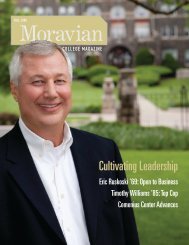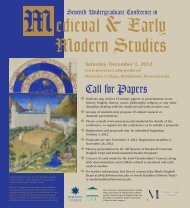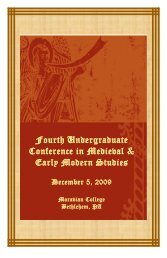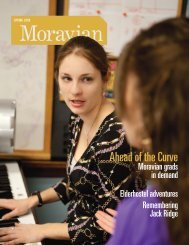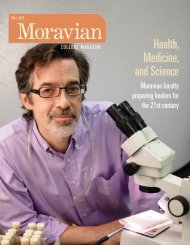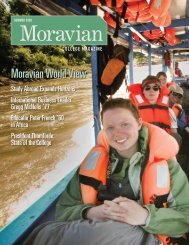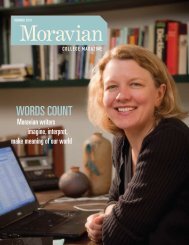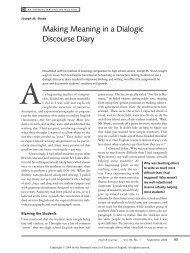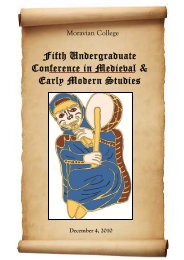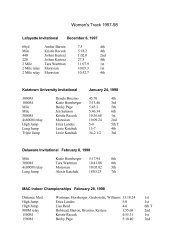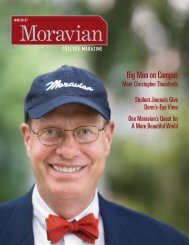MORAVIAN VISION - Moravian College
MORAVIAN VISION - Moravian College
MORAVIAN VISION - Moravian College
Create successful ePaper yourself
Turn your PDF publications into a flip-book with our unique Google optimized e-Paper software.
Embracing the Future<br />
Lyn Trodahl<br />
Chynoweth ’68<br />
Lyn Trodahl Chynoweth has served as<br />
a <strong>Moravian</strong> <strong>College</strong> trustee since 1991,<br />
and was named chair in October 2007.<br />
She served as chair of the board of the<br />
<strong>Moravian</strong> Theological Seminary from<br />
2000-2007, during which the Seminary<br />
launched a strategic plan. Lyn received<br />
the Medallion of Merit from the Alumni<br />
Association in May 2007. Currently an<br />
independent executive consultant, Lyn<br />
is retired from IBM where she held a<br />
range of executive and leadership<br />
positions in sales and consulting,<br />
advised business clients on organizational<br />
transformation, and received<br />
numerous leadership, management, and<br />
performance awards.<br />
PHOTO BY JOHN KISH IV<br />
><br />
One of the plan’s initiatives focuses on<br />
the Comenius Center, which currently offers<br />
many courses for adults to complete their<br />
undergraduate degrees, as well as offering<br />
a limited number of graduate degrees.<br />
When we looked at the demographics to<br />
understand what was needed for the Center<br />
to thrive, we realized we should offer more<br />
programs to meet the needs of the surrounding<br />
community. As a result, we are directing<br />
the Center to focus on graduate programs,<br />
and we are looking at adding more degrees<br />
that are in demand in this area.<br />
Do you feel the new plan will set <strong>Moravian</strong><br />
apart from other colleges?<br />
I do. I think higher education will see a lot<br />
of churn in the next few years. We have a history<br />
of preparing students to serve and lead<br />
in many different ways. We have two gorgeous<br />
and historic campuses. Our mission is unique<br />
in that it builds on the <strong>Moravian</strong> traditions<br />
of community, engagement in the world, and<br />
balance of body, mind, and spirit. If we can<br />
maintain our commitment to this mission, as<br />
well as to our vision to serve a changing student<br />
population, it will set us apart. We will<br />
continue to maintain our low faculty to student<br />
ratio. We have a very committed faculty,<br />
administration, and staff, as well as a strong<br />
student body. We have a lot of momentum, as<br />
evidenced by our continued strong enrollment.<br />
But we cannot rest on our laurels—we<br />
have a lot of hard work ahead.<br />
Which of the initiatives do you expect<br />
to be most challenging to achieve?<br />
Raising money is going to be a major challenge.<br />
The turbulence in the financial markets<br />
is sobering, and certainly poses uncertainty in<br />
the near future. And, although we have sound<br />
financial practices, I’d be lying if I said I was<br />
unconcerned. That said, the only responsible<br />
thing to do is to continue to put plans in place<br />
to raise funds to support the strategic plan.<br />
For example, a fairly low percentage of<br />
<strong>Moravian</strong> alumni gives money to the school<br />
[24% in 2008]. Whenever we talk to alums, almost<br />
to a one, they talk about the wonderful<br />
experience they had at <strong>Moravian</strong>. We’ve captured<br />
their hearts. Now we must find a way to<br />
reconnect them to the <strong>College</strong>, to make them<br />
understand how important it is for them to<br />
contribute their time, energy, and financial<br />
support to the best of their ability. Many<br />
alumni still are not aware that we need a<br />
higher percentage of giving simply to qualify<br />
for grants and funding from other sources.<br />
Every alum can give something—that’s really<br />
important.<br />
How will we measure our success in<br />
meeting the plan’s objectives?<br />
We are working on this. We received a<br />
very strong report from the Middle States Accreditation<br />
last year, along with some suggestions<br />
regarding assessment. The administration<br />
is merging those recommendations with<br />
our strategic initiatives and recommending<br />
ways to measure success. We hope to have<br />
some sort of scorecard or dashboard that<br />
tracks progress toward achieving specific<br />
goals—both institutional and within individual<br />
disciplines. I suspect we’re farther ahead<br />
than many schools; but we do recognize the<br />
need for assessment, and we take it seriously.<br />
What will the overall landscape be for<br />
higher education in the coming years?<br />
Higher education will undergo a lot of<br />
change. We all will need to address issues of<br />
affordability, loan availability, shifting demographics,<br />
infusion of technologies, shifts<br />
in government oversight—to name a few.<br />
Only those schools that have a clear, focused<br />
mission and that are well-run will survive.<br />
I believe <strong>Moravian</strong> will be one that will not<br />
just survive, but will thrive. It will require a<br />
lot of focused effort and hard work from all<br />
of us—but it is well worth it. Quite. �<br />
12 <strong>MORAVIAN</strong> COLLEGE MAGAZINE FALL 2008



